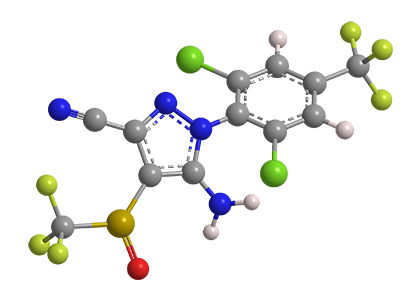What molecule am I?


Fipronil is a broad-spectrum insecticide. It disrupts insects’ central nervous systems by blocking chloride channels that are gated by γ-aminobutyric acid (GABA) or glutamate. These receptors are weaker or nonexistent in mammals.
Fipronil has a chiral center at the sulfur atom in the sulfoxide group; the two enantiomers have been isolated and verified. The article of commerce is a racemic mixture of the two.
Fipronil formulations sold worldwide include flea-control products for pets, cockroach traps, and insecticides for agrciultural crops, lawns, golf courses, and the like. But despite its wide range of uses and relative harmlessness toward mammals, fipronil is a significant environmental hazard. It is highly toxic to fish and other waterborne wildlife, birds, and beneficial insects. It has been cited as one of the primary causes of honeybee die-off.
In 2017, fipronil was the culprit in a food-contamination scandal in the Netherlands. Molecule of the Week’s Dutch reader who suggested this molecule provided this narrative:
- Egg-laying chickens in the Netherlands are plagued by red mites (bloodmites, Dermanyssus gallinae), which cause anemia and reduce egg output.
- To combat these mites, farmers turned to a tiny company in the Netherlands called Chickfriend. The company offered an effective way to exterminate the mites by fumigation.
- Chickfriend helped hundreds of chicken farmers get rid of the mites for months.
- But—it turned out that Chickfriend’s fumigant contained fipronil, which was banned in the Netherlands. Contamination of Dutch eggs, which are sold worldwide, plunged the industry into a tailspin, with estimated damages running into the hundreds of millions of euros.
A recent article in the Dutch newspaper De Stentor chronicles the fipronil scandal, including the subsequent legal fallout and a better way to combat red mites. (Note: The article is in Dutch, but it is easily translated by major Web browsers.)
Fipronil hazard information
| Hazard class* | Hazard statement | |
|---|---|---|
| Acute toxicity, oral, category 3 | H301—Toxic if swallowed | |
| Acute toxicity, dermal, category 3 | H311—Toxic in contact with skin | |
| Serious eye damage/eye irritation, category 2A | H319—Causes serious eye irritation | |
| Acute toxicity, inhalation, category 3 | H331—Toxic if inhaled | |
| Specific target organ toxicity, repeated exposure, oral, category 1 | H372—Causes damage to organs through prolonged or repeated exposure if swallowed | |
| Short-term (acute) aquatic hazard, category 1 | H400—Very toxic to aquatic life | |
| Long-term (chronic) aquatic hazard, category 1 | H410—Very toxic to aquatic life with long-lasting effects | |
*Globally Harmonized System of Classification and Labeling of Chemicals.
Explanation of pictograms.
This molecule was suggested by a reader. We present almost all of the molecules suggested by our readers. If you have a molecule you would like us to consider, please send us a message. And thank you for your interest in Molecule of the Week! —Ed.
Fipronil fast facts
| CAS Reg. No. | 120068-37-3 |
| SciFinder nomenclature | 1H-Pyrazole-3-carbonitrile, 5-amino-1-[2,6-dichloro-4-(trifluoromethyl) phenyl]-4-[(trifluoromethyl) sulfinyl]- |
| Empirical formula | C12H4Cl2F6N4OS |
| Molar mass | 437.15 g/mol |
| Appearance | White to yellow powder |
| Melting point | 200.5 ºC |
| Water solubility | 2 mg/L |
MOTW update:
April 24, 2023
Fipronil1 is a broad-spectrum insecticide with several known environmental hazards, including contamination of chicken eggs in the Netherlands in 2017. Earlier this month, Weidong Qu and colleagues at Fudan University (Shanghai), the China National Center for Food Safety Risk Assessment (Beijing), Qingdao University (China), and Oxford University (UK) reported that fipronil and its metabolites in drinking water can produce thyroid-disrupting effects in humans.
1. CAS Reg. No. 120068-37-3.

Learn more about this molecule from CAS, the most authoritative and comprehensive source for chemical information.
Molecule of the Week needs your suggestions!
If your favorite molecule is not in our archive, please send us a message. The molecule can be notable for its current or historical importance or for any quirky reason. Thank you!
Stay Ahead of the Chemistry Curve
Learn how ACS can help you stay ahead in the world of chemistry.

